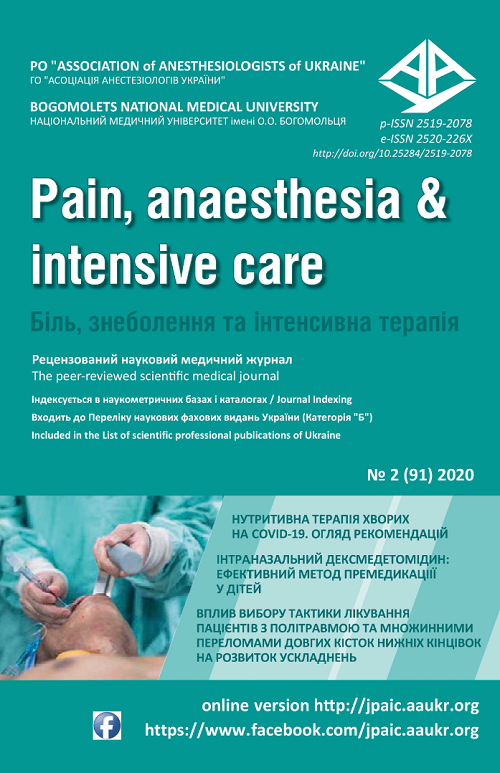ПРОГНОСТИЧНА ЗНАЧУЩІСТЬ РІЗНИХ БІОМАРКЕРІВ ЩОДО СИНДРОМУ ПОЛІОРГАННОЇ НЕДОСТАТНОСТІ У ПАЦІЄНТІВ В АБДОМІНАЛЬНІЙ ХІРУРГІЇ
DOI:
https://doi.org/10.25284/2519-2078.2(91).2020.205604Ключові слова:
синдром поліорганної недостатності, креатинін, альбумін, холестерин, С-реактивний білок, Sequential Organ Failure Assessment (SOFA), Acute Physiology and Chronic Health Evaluation III (APACHE III)Анотація
Мета: визначити прогностичну значимість, чутливість і специфічність різних клініко-лабораторних показників і прогностичних шкал у пацієнтів з розвитком сепсису і синдрому поліорганної недостатності (СПОН) після абдомінальних хірургічних втручань.
Матеріал і методи. Проведено проспективне когортне дослідження у 431 пацієнта з абдомінальної хірургічної патологією, яким визначали ряд клінічних та лабораторних показників у 1-3 добу після перенесених оперативних втручань. Були виділені дві групи: перша (n = 255) – без ознак СПОН, друга (n = 176) – з наявністю СПОН.
Результати. Найбільшу прогностичну цінність щодо СПОН протягом 1-3 діб після операції мають шкали SOFA (AUC 0.825- 0.899) і APACHE III (AUC 0.690-0.768). Як скринінгові маркери СПОН в 1-у добу після операції нами запропоновано використовувати креатинін (AUC 0.722) і холестерин (AUC 0.682). На 2-у добу після операції запропоновано використовувати креатинін (AUC 0.631), альбумін (AUC 0.752), холестерин (AUC 0.671) і С-реактивний білок (AUC 0.815). На 3-ю добу після операції запропоновано використовувати альбумін (AUC 0.690), холестерин (AUC 0.688) і С-реактивний білок (AUC 0.772).
Висновок. Шкала SOFA має переваги в порівнянні зі шкалою APACHE III для прогнозування СПОН. Пацієнтам після абдомінальних операцій при надходженні у відділення анестезіології та реанімації як скринінг СПОН потрібно визначати показники креатиніну, альбуміну, холестерину і С-реактивного білка.
Посилання
Fleischmann C, Scherag A, Adhikari NK, Hartog CS, Tsaganos T, Schlattmann P, et al. Assessment of global incidence and mortality of hospital treated sepsis. Current estimates and limitations. Am J Respir Crit Care Med. 2016; 193: 259-72.
 |
|  |
| 
Blanco J, Muriel-Bombín A, Sagredo V, Taboada F, Gandía F, Tamayo L, et al. Incidence, organ dysfunction and mortality in severe sepsis: a Spanish multicentre study. Crit Care. 2008; 12: R158.
 |
|  |
| 
Rhodes A, Evans LE, Alhazzani W, Levy MM, Antonelli M, Ferrer R, et al. Surviving Sepsis Campaign: International Guidelines for Management of Sepsis and Septic Shock: 2016. Intensive Care Med. 2017; 43: 304-77.
 |
|  |
| 
Reinhart K, Daniels R, Kissoon N, Machado FR, Schachter RD, Finfer S. Recognizing sepsis as a global health priority – a WHO resolution. N Engl J Med. 2017; 377: 414-7.
 |
|  |
| 
Singer M, Deutschman CS, Seymour CW, Shankar-Hari M, Annane D, Bauer M, et al. The Third International Consensus Defi nitions for Sepsis and Septic Shock (Sepsis-3). JAMA 2016; 315: 801-10.
 |
|  |
| 
Vincent J L, Teixeira L. Sepsis biomarkers. Value and limitations. Am J RespirCrit Care Med. 2014; 190: 1081-2.
 |
|  |
| 
Pierrakos C, Vincent JL. Sepsis biomarkers: a review. Crit Care. 2010; 14: R15.
 |
|  |
| 
Schmidt de Oliveira-Netto AC, Morello LG, Dalla-Costa LM, Petterle RR, Fontana RM, Conte D, et al. Procalcitonin, C-reactive protein, albumin, and blood cultures as early markers of sepsis diagnosis or predictors of outcome: a prospective analysis. Clin Pathol. 2019; 12: 2632010X19847673.
 |
|  |
| 
Giardino A, Spolverato G, Regi P, Frigerio I, Scopelliti F, Girelli R, et al. C-Reactive Protein and Procalcitonin as Predictors of Postoperative Infl ammatory Complications After Pancreatic Surgery. J Gastrointest Surg. 2016; 20: 1482-92.
 |
|  |
| 
Abu Elyazed MM, El Sayed Zaki M. Value of procalcitonin as a biomarker for postoperative hospital-acquired pneumonia after abdominal surgery. Korean J Anesthesiol. 2017; 70: 177-83.
 |
|  |
| 
Leliefeld PH, Wessels CM, Leenen LP, Koenderman L, Pillay J. The role of neutrophils in immune dysfunction during severe infl ammation. Crit Care. 2016; 20: 73.
 |
|  |
| 
Lee MA, Choi KK, Yu B, Park JJ, Park Y, Gwak J, et al. Acute physiology and chronic health evaluation II score and sequential organ failure assessment score as predictors for severe trauma patients in the intensive care unit. Korean J Crit Care Med. 2017; 32: 340-6.
 |
| 
Naqvi IH, Mahmood K, Ziaullaha S, Kashif SM, Sharif A. Better prognostic marker in ICU - APACHE II, SOFA or SAP II! Pak J Med Sci. 2016; 32: 1146-51.
 |
|  |
| 
Kądziołka I, Świstek R, Borowska K, Tyszecki P, Serednicki W. Validation of APACHE II and SAPS II scales at the intensive care unit along with assessment of SOFA scale at the admission as an isolated risk of death predictor. Anaesthesiol Intensive Ther. 2019; 51: 107-11.
 |
|  |
| 
Qin W, Zhang X, Yang S, Li Y, Yuan J, Yang L, et al. Risk factors for multiple organ dysfunction syndrome in severe stroke patients. PLoS One. 2016; 11: e0167189.
 |
|  |
| 
Kong T, Park YS, Lee HS, Kim S, Lee JW, You JS, et al. The delta neutrophil index predicts development of multiple organ dysfunction syndrome and 30-day mortality in trauma patients admitted to an intensive care unit: a retrospective analysis. Sci Rep. 2018; 8: 17515.
 |
|  |
| 
Feng JY, Chien JY, Kao KC, Tsai CL, Hung FM, Lin FM, et al. Predictors of early onset multiple organ dysfunction in major burn patients with ventilator support: experience from a mass casualty explosion. Sci Rep. 2018; 8: 10939.
 |
|  |
| 
Lendak DF, Mihajlović DM, Novakov-Mikić AS, Boban JM, Ubavić M, Brkić SV. APRIL and sTACI could be predictors of multiorgan dysfunction syndrome in sepsis. Virulence. 2018; 9: 946-53.
 |
|  |
| 
Osipenko AN, Marochkov AV. Blood plasma plasmalogens and fatty acids in multiple organ dysfunction syndrome. Crit Care Shock. 2017; 20: 40-5.

Stojanovic M, Svorcan P, Karamarkovic A, Ladjevic N, Jankovic R, Stevanovic P. Mortality predictors of patients suffering of acute pancreatitis and development of intraabdominal hypertension. Turk J Med Sci. 2019; 49: 506-13.
 |
|  |
| 
Li H, Shan-Shan Z, Jian-Qiang K, Ling Y, Fang L. Predictive value of C-reactive protein and NT-pro-BNP levels in sepsis patients older than 75 years: a prospective, observational study. Aging Clin Exp Res. 2020; 32: 389-397.
 |
|  |
| 
Pregernig A, Müller M, Held U, Beck-Schimmer B. Prediction of mortality in adult patients with sepsis using six biomarkers: a systematic review and meta-analysis. Ann Intensive Care. 2019; 9: 125.
 |
|  |
| 
Nagae M, Egi M, Kubota K, Makino S, Mizobuchi S. Association of direct bilirubin level with postoperative outcome in critically ill postoperative patients. Korean J Anesthesiol. 2018; 71: 30-6.
 |
|  |
| 
Ricciuto DR, dos Santos CC, Hawkes M, Toltl LJ, Conroy AL, Rajwans N, et al. Angiopoietin 1 and angiopoietin 2 as clinically informative prognostic biomarkers of morbidity and mortality in severe sepsis. Crit Care Med. 2011; 39: 702-10
 |
| 
##submission.downloads##
Опубліковано
Як цитувати
Номер
Розділ
Ліцензія
Авторське право (c) 2020 Біль, знеболення та інтенсивна терапія

Ця робота ліцензується відповідно до Creative Commons Attribution-NonCommercial 4.0 International License.
Автори, які публікуються у цьому журналі, погоджуються з наступними умовами:
a. Автори залишають за собою право на авторство своєї роботи та передають журналу право першої публікації цієї роботи на умовах ліцензії Creative Commons Attribution-NonCommercial 4.0 International License, котра дозволяє іншим особам вільно розповсюджувати опубліковану роботу з обов'язковим посиланням на авторів оригінальної роботи та першу публікацію роботи у цьому журналі.
b. Автори мають право укладати самостійні додаткові угоди щодо неексклюзивного розповсюдження роботи у тому вигляді, в якому вона була опублікована цим журналом (наприклад, розміщувати роботу в електронному сховищі установи або публікувати у складі монографії), за умови збереження посилання на першу публікацію роботи у цьому журналі.
c. Політика журналу дозволяє і заохочує розміщення авторами в мережі Інтернет (наприклад, у сховищах установ або на особистих веб-сайтах) рукопису роботи, як до подання цього рукопису до редакції, так і під час його редакційного опрацювання, оскільки це сприяє виникненню продуктивної наукової дискусії та позитивно позначається на оперативності та динаміці цитування опублікованої роботи (див. The Effect of Open Access).








